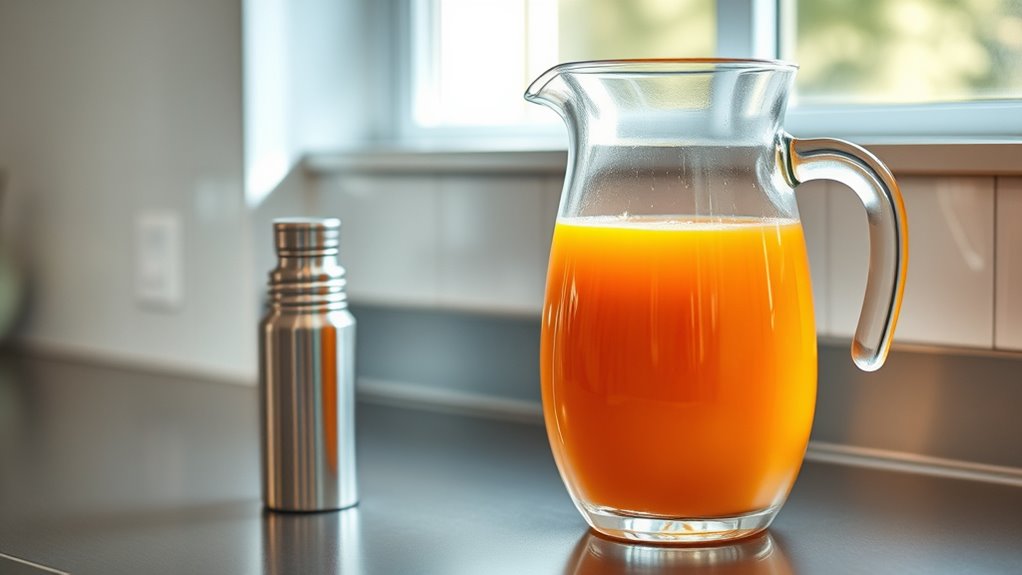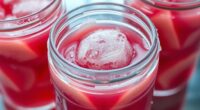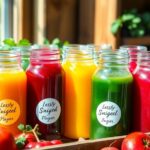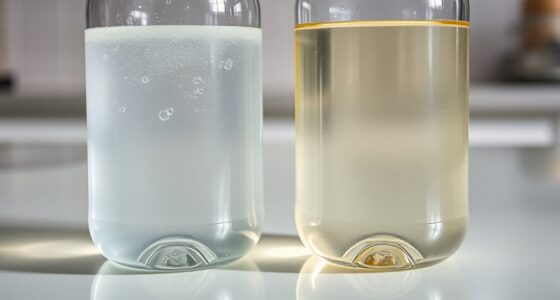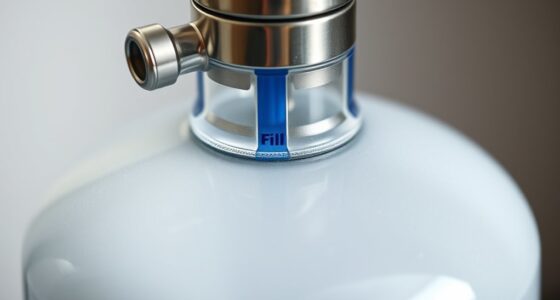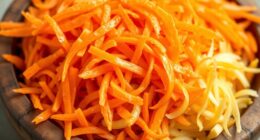To reduce oxidation when storing fresh juice, use airtight, non-reactive containers like glass bottles with tight-fitting lids or BPA-free plastics. Fill them close to the top, cap tightly, and keep the juice cold in the refrigerator’s crisper drawer at 32°F to 39°F. Consume within 24 to 48 hours for the best flavor and nutrients. Proper storage methods will help maintain quality—and you’ll find tips that can make a difference as you explore further.
Key Takeaways
- Use airtight, non-reactive containers like glass bottles to minimize oxygen exposure.
- Fill containers close to the top and cap tightly before refrigerating to reduce air contact.
- Store juice at cold temperatures between 32°F and 39°F to slow oxidation.
- Consume within 24 to 48 hours to preserve freshness and nutrient quality.
- Label containers with the juicing date and avoid storing in door compartments for consistency.
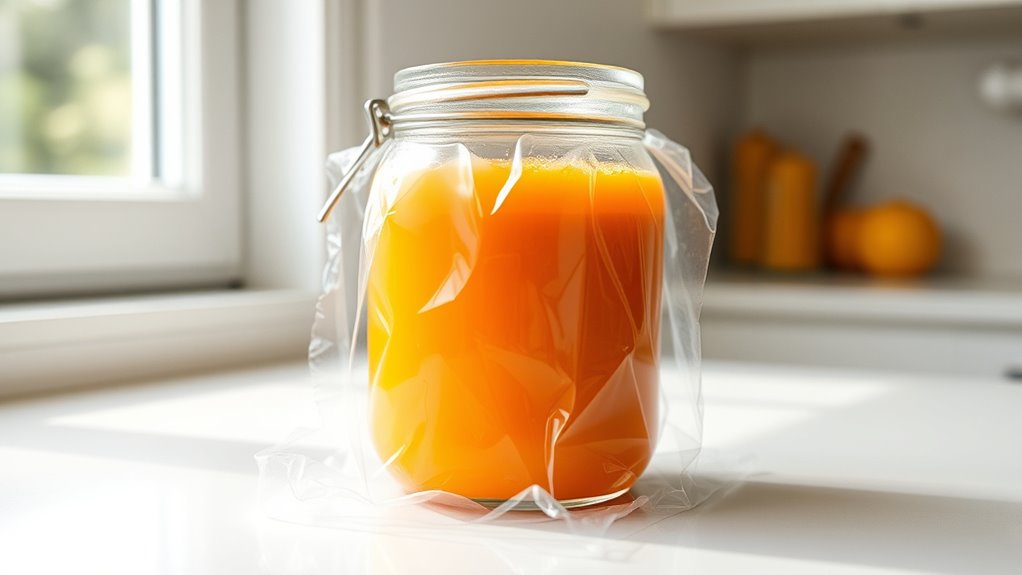
Storing fresh juice properly guarantees it stays flavorful and nutritious for as long as possible. One of the most important factors in preserving your juice’s quality is choosing the right juice container options. Opt for airtight, non-reactive containers such as glass bottles with tight-fitting lids or BPA-free plastic bottles designed for liquids. Glass is preferable because it doesn’t leach chemicals and is less likely to react with the acidity of the juice, which can accelerate oxidation. When selecting a container, make sure it’s clean and free of residual odors, as these can affect the taste of your juice. Filling the container as close to the top as possible minimizes the amount of air inside, further reducing oxidation risks. Also, avoid using containers that aren’t designed for storing liquids, as they might leak or degrade over time. Proper storage minimizes environmental impacts and extends shelf life, which is especially important for reducing food waste.
In addition to choosing the right container, paying attention to the crucial storage temperature is essential. Juice should be kept cold, ideally between 32°F and 39°F (0°C and 4°C), to slow down oxidation and microbial growth. The cold suppresses enzyme activity that can cause spoilage and helps maintain the juice’s vibrant flavor and nutrients. If your refrigerator has a dedicated crisper drawer, consider storing your juice there, as it often maintains a more consistent temperature and humidity level. Avoid storing juice in the door compartments, where temperature fluctuations are more common due to frequent opening. When you pour your juice into a container, do so quickly to minimize oxygen exposure, and cap it tightly before putting it in the fridge. Proper storage practices help mitigate the harmful effects of air pollution and microbial activity on your juice.
It’s also wise to consume the juice within a few days of juicing, ideally within 24 to 48 hours for maximum freshness. The longer it sits, the more it oxidizes, losing its bright flavor and valuable nutrients. If you need to store it longer, consider freezing it in appropriate containers, but be aware that freezing may slightly alter the texture and flavor upon thawing. Always label your containers with the date of juicing so you can keep track of freshness. Properly storing fresh juice with the right container options and at the optimal storage temperature ensures you enjoy its full benefits, with maximum flavor and minimal nutrient loss.
Frequently Asked Questions
Can Adding Preservatives Extend Juice Shelf Life?
Adding preservatives can extend your juice’s shelf life, but choose natural preservatives like lemon juice or vitamin C to keep it safe and fresh. Always prioritize additive safety by avoiding artificial chemicals. Natural preservatives help slow oxidation and prevent spoilage without compromising quality. Be sure to store your juice properly in airtight containers and keep it refrigerated, ensuring you enjoy fresh-tasting juice for longer without risking health or flavor.
What Types of Containers Best Prevent Oxidation?
You should use airtight containers and dark glass bottles to prevent oxidation. Airtight containers keep oxygen out, slowing down spoilage, while dark glass protects the juice from light that accelerates oxidation. Store your juice in these containers in the fridge, and avoid opening them frequently. This combination effectively preserves freshness, maintains flavor, and extends shelf life by minimizing contact with oxygen and light.
Does Storing Juice in the Freezer Affect Flavor?
Freezing transforms juice into a frozen time capsule, but beware—the freezing effects can subtly alter flavor. While it preserves freshness and slows oxidation, some delicate nuances might fade or change when thawed. You’ll find that flavor preservation is generally good, yet a slight loss of brightness may occur. To enjoy the best taste, consume frozen juice promptly and thaw it slowly to minimize flavor changes.
How Does Temperature Influence Juice Oxidation Rates?
Temperature control plays a vital role in slowing down the oxidation speed of your juice. When you keep it cold, oxidation happens more slowly, preserving flavor and nutrients longer. If the temperature rises, oxidation speeds up, causing your juice to spoil faster. To maximize freshness, store your juice at consistently low temperatures, ideally in an airtight container, and avoid temperature fluctuations that can accelerate oxidation.
Is Vacuum Sealing Effective for Preserving Fresh Juice?
Vacuum sealing is like locking in freshness; it’s quite effective for preserving juice. By removing oxygen, it slows down oxidation and keeps your juice tasting fresh longer. When you vacuum seal, you create an airtight environment that prevents air from spoiling the juice. This method markedly extends shelf life, making it a smart choice for storing fresh juice and maintaining its quality without preservatives.
Conclusion
By sealing your fresh juice tightly and storing it in the cold, you’re locking in its vibrant energy, like capturing sunlight in a bottle. Think of your juice as a delicate gem—exposed to air, it dulls quickly. So, treat it with care, keep it chilled, and enjoy every drop at its freshest. When stored properly, your juice remains a lively symphony of flavors, ready to brighten your day like a burst of morning sunshine.
Cindy thoroughly researches juicing trends, techniques, and recipes to provide readers with practical advice and inspiration. Her writing style is accessible, engaging, and designed to make complex concepts easy to understand. Cindy’s dedication to promoting the advantages of juicing shines through her work, empowering readers to make positive changes in their lives through the simple act of juicing.

